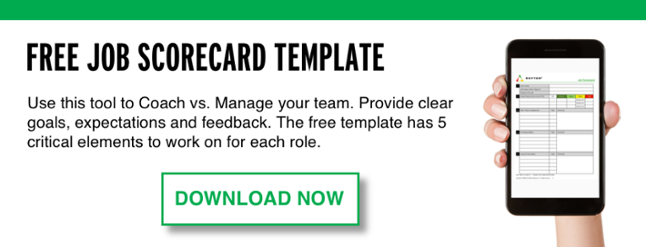Topgrading is a methodology of recruiting, interviewing, selecting and retaining top talent developed by Brad  Smart and Geoff Smart designed to increase your likelihood of hiring and retaining A players. We’ve been recommending this method to Rhythm clients for many years. We even use it ourselves, so we know firsthand the power of Topgrading. You can find many great (and free) resources on their website. When used in conjunction with Job Scorecards, an enhanced version of job descriptions, you can better attract and retain the A-Players you need to hit your growth goals.
Smart and Geoff Smart designed to increase your likelihood of hiring and retaining A players. We’ve been recommending this method to Rhythm clients for many years. We even use it ourselves, so we know firsthand the power of Topgrading. You can find many great (and free) resources on their website. When used in conjunction with Job Scorecards, an enhanced version of job descriptions, you can better attract and retain the A-Players you need to hit your growth goals.
Topgrading Interview questions and process
- Get clear about YOUR Topgrading definition of an A-Player. We like to combine the traditional Topgrading definition of an A Player, “one who qualifies among the top 10% of talent available for a certain position,” with Jack Welch’s philosophy that A players will not only be able to consistently deliver good results but will also do it in a way that is aligned with your Core Values. Whatever definition you choose to use, discuss it with your team, clarify the expectations and document your definition and criteria so everyone uses the term in the same way. This is often overlooked in the hiring process; remember, your not just trying to find the best candidate, you are trying to find your best candidate, and they will need to share your core values.
- Create Job Scorecards. The only way to know for sure if someone is delivering good results is to get clear about what the results should be. You can use our Job Scorecard tool to clarify the detailed job Purpose, Desired Results, Skills & Competencies, Key Responsibilities and Core Values you want to use to evaluate employees and candidates consistently. Everyone deserves the gift of clear goals and expectations, so you will eventually want to create a Job Scorecard for everyone in your company, but at the very least, you should commit to not hiring another person until you create a Job Scorecard for that particular position.
- Figure out who your A Players are. A Players attract A Players. Using your definition of an A Player, evaluate how many on your team are already A Players and involve them in the recruiting and selection process. Your goal over time is to have all A Players, so if you’re not at 100% today (and most companies aren’t), this evaluation will give you a baseline to improve on over time. These are your top performers that consistently produce and enhance the company culture. The A-Players profile includes skills, experience and personalities of your best employees, going all the way back to high school to show a consistent pattern of excellence. Keeping A Players is necessary to win the talent war.
- Recruit first from within your networks. Once you have a clear idea of what you’re looking for, start by sharing it with people you know, trust and admire to see if they can recommend anyone for you to contact. There is no better reference than someone choosing to work with an individual for a second time, so if one of your A Players recommends you talk to someone they used to work with, you should pay very close attention.
- Follow the recommended Topgrading interview process:
- Telephone Screening Interview - This phone interview is designed to eliminate bad matches early on and save you time in the long run. You need to develop a consistent process for conducting these interviews. You should have a few deal-breaker questions in the beginning, and if the candidate makes it past those, be prepared to spend 30-45 minutes asking more detailed questions and sharing what the position will require. If not, the interview should be pretty short. If all goes well with the next set of questions and you believe you have a potentially good candidate, and the candidate is interested in pursuing the position, the next step will be Competency Interviews.
- Competency Interviews - These are more traditional interviews where the candidate meets with different people in the company who evaluate the candidate's knowledge, skills and background. This is an important step, but one that, with the right interview skills training, a bad candidate could slip through. If the candidate makes it though this step, reference checks are positive, and the a player is still excited about the position, the next step is the Topgrading Interview.
- Topgrading Interview - This is a lengthy, in-depth, chronological interview conducted by multiple people in the company at one time, not just the hiring manager. This is an integral part of the hiring process. It usually lasts 4-6 hours and covers the candidate's entire work history and personal accomplishments. This takes time, but nothing is worth the staggering cost of a mis hire and all the hours wasted in training and finding a new candidate to replace them. Topgrading interview questions are not just about skills. They are about the person's character and fit in your company. Hire slow and fire fast is a key component to the Topgrading method.
- Don’t skimp on the Topgrading Interview. Topgrading calls this the “silver bullet” of hiring. They provide training, a guide, workshops, books and other resources on just this one step. It requires a huge investment of time and energy from you and your team, but the results are worth it. Spending this much time with a candidate and following the correct format and process will give you a glimpse into the real person you are considering and will allow you to recognize patterns throughout their history that will give you a much higher likelihood of choosing the right person for your company and this particular position. This is usually a team or tandem interview, so that you'll get a better idea of how they'll fit with the team. It’s disappointing to get a candidate to this step and invest the hours needed to do it well, only to find out they weren’t a good fit after all, and you can’t extend an offer. But once you experience that “aha” moment (and dodge that bad hire bullet), you will never hire another person without conducting a Topgrading Interview again. You will be amazed at what people will reveal about themselves in the third or fourth hour of one of these interviews.
- Make sure the candidate is as excited about you as you are about them. It is possible to find what appears to be your dream candidate, but keep in mind that it’s just as important for them to be as excited and in love with you, your company, and this position as you are with them. The last thing you need is a reluctant new hire or someone who feels like they might be settling for something that isn’t a great fit for them. Look for clues in the Topgrading Interview and come right out and ask them if necessary. They will appreciate your candor.
- By all means, don’t skip the reference calls. No matter how great someone does in the Topgrading Interview, never make an offer before speaking with their references. Topgrading offers some specific recommendations about how to arrange and conduct these reference calls, including involving the candidate in arranging the calls. They need to know you will call and you need to follow through.
- Give your new hire a Great First Day & on-boarding experience. Congratulations! If you've made it to tip # 9, you have just made a great addition to your team. Now continue to invest in that new hire by ensuring they have everything they need to enter your company and culture successfully. Here’s a link to a blog that shares some of our favorite ideas to get them off on the right foot.
- Create a KPI to measure your hiring success. Successful recruiting and hiring requires patience, skill, practice, and evaluation. Make sure you stay honest with yourself about how you’re doing. Over time, you should see the percentage of A Players on your team increase, turnover decrease, productivity increase and employee satisfaction soar. Ask yourself what success looks like for your company and put the right metrics in place to measure yourself.
Those that follow the Topgrading interview process and the use Topgrading methodology are a step ahead of the competition in building the best team available. Good luck and hire well!
The Power of Systems and People: Accountable Leaders and Teams
Use Job Scorecards to Build Team Accountability
Don't Get Stuck on Your Job Scorecard
Use Your Core Values and Job Scorecards in Your Hiring Process
How to Roll Out Job Scorecards in Your Organization
The Staggering Cost of a Mis-Hire: Use Job Scorecards Instead
The 5 C's of Team Accountability
Why Traditional Performance Appraisals Might Be A Big Mistake (And What To Do Instead)
Rhythm Systems Employee Engagement Resource Center




